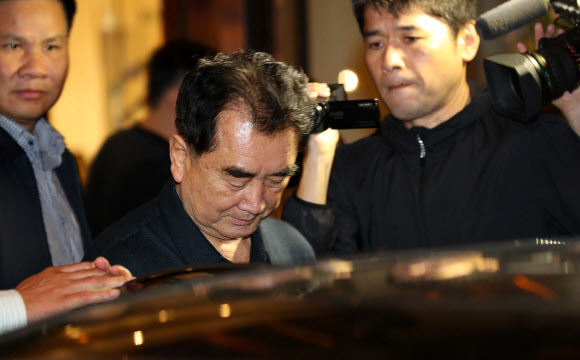 |
|
North Korean State Affairs Commission Chief Secretary Kim Chang-son leaves his accommodations in Hanoi, Vietnam, shortly after his arrival for the second North Korea-US summit on Feb. 17. (Yonhap News)
|
Agreements reached then echo discussion surrounding 2nd N. Korea-US summit
The agreement reached on Feb. 13, 2007, at the Six-Party Talks on the North Korean nuclear issue is drawing new attention amid predictions that the second North Korea-US summit in Hanoi on Feb. 27–28 will include discussions on dismantlement of North Korea’s Yongbyon nuclear facilities and corresponding measures from the US. The Feb. 13 agreement represents the first and last document to date to include content specifically mentioning North Korea’s closure of the Yongbyon facilities and the establishment of full-scale diplomatic ties with the US. The Feb. 13 agreement contains initial denuclearization measures by the North to implement its pledges for denuclearization of the Korean Peninsula and normalization of relations with the US according to the Joint Statement from Sept. 19, 2005, along with mutually coordinated measures from the US in response. The content echoes the second North Korea-US summit’s role as a setting for negotiating practical steps to implement the more general agreement reached at the first summit on June 12 of last year. In the Feb. 13 agreement, North Korea pledged to dismantle and seal its nuclear facilities at Yongbyon and allow the return of International Atomic Energy Agency (IAEA) inspectors. In response, the US was to initiate dialogue toward establishing full-scale diplomatic relations with the North, begin the process of removing North Korea’s designation as a state sponsor of terrorism, and provide one million tons of heavy fuel oil in economic and energy support. The items are noteworthy in light of the North’s reported demands ahead of the second North Korea-US summit for corresponding US measures in exchange for dismantling the Yongbyon nuclear facilities, which include a declaration ending the Korean War, the establishment of a joint liaison office, and the removal of sanctions to resume Mt. Kumgang tourism and Kaesong Industrial Complex operations. Also noteworthy is the Feb. 13 agreement’s inclusion of a plan to establish working groups to discuss implementation plans for major agenda areas. In the agreement, North Korea and the US agreed to operate a total of five working groups to work on denuclearization of the Korean Peninsula, the normalization of North Korea-US relations, the normalization of North Korea-Japan relations, economic and energy-related cooperation, and the establishment of a multilateral peace and security regime in Northeast Asia. The agreement also included plans for the “directly related parties [to] negotiate a permanent peace regime on the Korean Peninsula at an appropriate separate forum.” The content is reminiscent of the 2019 New Year address by North Korean leader Kim Jong-un, where he mentioned “multi-party negotiations for replacing the current ceasefire on the Korean peninsula with a peace mechanism.“ At the Six-Party Talks on Oct. 3, 2007, North Korea and the US heard and approved reports from the five working groups and agreed upon measures for a second stage of implementation. By the end of the year, North Korea agreed to disable its 5MWe experimental reactor and reprocessing facilities at Yongbyon, along with facilities for the production of nuclear fuel rods, and to provide full and accurate reporting on its nuclear program. After some bumps in the road concerning the lifting of sanctions on North Korean accounts at Macau’s Banco Delta Asia (BDA), the Oct. 3 agreement finally led to North Korea’s submission of a nuclear report and demolition of a cooling tower at Yongbyon in June the following year, which led to a removal of North Korea’s state sponsor of terrorism status the following October. In a recent talk at the National Assembly, Moon Chung-in, special presidential advisor for unification, foreign affairs and national security, proposed discussions at the second North Korea-US summit toward the establishment of a working group to implement the agreement from the first. He also made reference to the Feb. 13 agreement in an interview with Japan’s Yomiuri Shimbun newspaper published on Feb. 18, suggesting the summit “could be considered a success” if the North Korean and US leaders agree to form three working groups to discuss improvement of bilateral relations, an end-of-war declaration and peace agreement, and denuclearization. By Yoo Kang-moon, senior staff writer Please direct comments or questions to [english@hani.co.kr]






